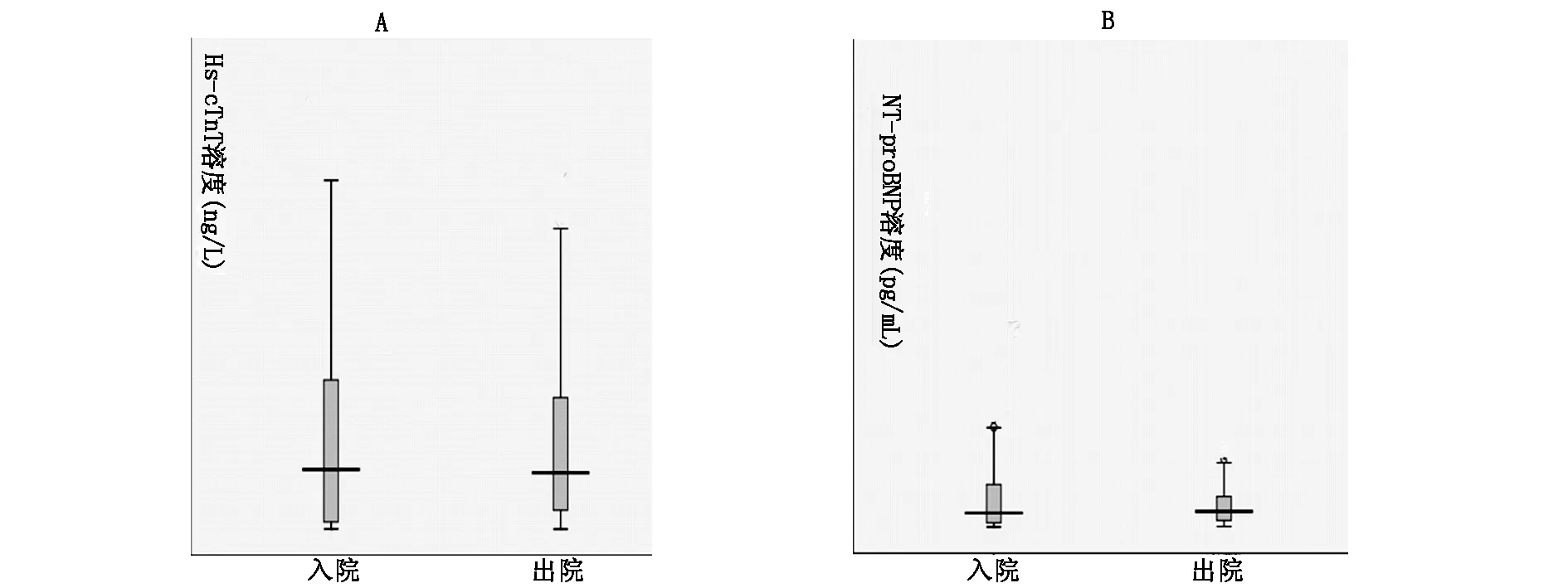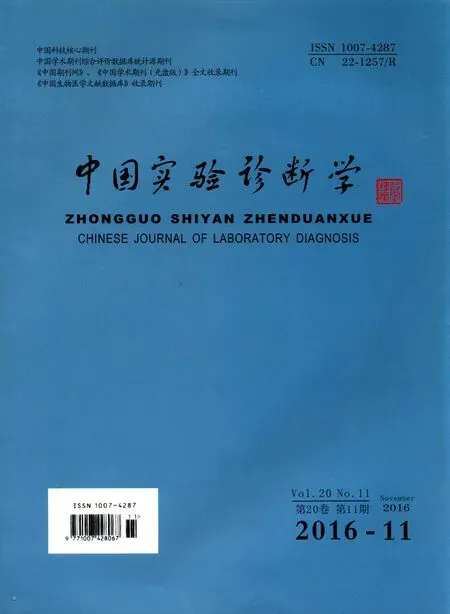hs-cTnT和NT-proBNP在急性心肌梗死患者预后中的价值研究
周莉莎,赵珍珍,李贵星,郭 英,都向阳,黄 俊
(四川大学华西医院 实验医学科,四川 成都610041)
hs-cTnT和NT-proBNP在急性心肌梗死患者预后中的价值研究
周莉莎,赵珍珍,李贵星*,郭 英,都向阳,黄 俊
(四川大学华西医院 实验医学科,四川 成都610041)
目的 探索hs-cTnT和NT-proBNP在急性心肌梗死患者预后中的临床价值。方法 纳入2013年1月至2014年12月共347例AMI患者为研究对象,按预后分为预后良好组(272例)和预后不良组(75例)。比较两组患者hs-cTnT和NT-proBNP水平,分析预后良好组和预后不良组入院及出院hs-cTnT和NT-proBNP水平差异。结果 在预后不良组中出院hs-cTnT水平为3127.0(1638.0-6054.0)ng/L,高于入院hs-cTnT的1390.0(291.7-4189.0)ng/L(P<0.05);出院NT-proBNP水平为4817.0(2585.0-12010.0) pg/ml,高于入院NT-proBNP的1775.0(432.0-5431.0) pg/ml(P<0.05)。预后良好组入院和出院时hs-cTnT和NT-proBNP变化差异无统计学意义(P>0.05)。预后不良组出院hs-cTnT为3127.0(1638.0-6054.0)ng/L和出院NT-proBNP为4817.0(2585.0-12010.0) pg/ml,高于预后良好组出院hs-cTnT的1196.5(398.3-2787.0)ng/L和出院NT-proBNP的1329.0(567.8-2592.5)pg/ml,差异有统计学意义(P<0.05)。结论 AMI患者出院hs-cTnT和NT-proBNP比入院时增加预示患者预后不好。动态分析AMI患者hs-cTnT和NT-proBNP水平对患者预后判断有价值。
hs-cTnT;NT-proBNP;急性心肌梗死;预后
(ChinJLabDiagn,2016,20:1859)
急性心肌梗死(acute myocardial infarction,AMI)是冠心病的急重症,在我国其发病率、致残率和死亡率高,是严重危害人类健康的一类心血管疾病,文献报道在美国AMI的院内死亡率高达5.4%[1-3]。临床评估AMI患者的预后非常重要,有助于识别高危人群,制定合理的治疗策略,降低死亡率、改善预后。大量研究已经证明高敏肌钙蛋白T(high sensitivity cardiac troponin T,hs-cTnT)是心肌细胞损伤的敏感性、特异性标志物,在急性冠脉综合征早期诊断,治疗评估,危险分层中具有重要应用价值[4-6]。B型利钠肽(B-type natriuretic peptide,BNP)是由心室肌细胞分泌的神经肽类激素,具有扩张血管、抑制交感神经系统、促进水钠排泄、维持体液平衡等重要生理功能[7],BNP 在心力衰竭诊断、治疗评价和预后评估中应用广泛[8]。近年来研究发现BNP或N-未端利钠肽前体(NT-proBNP)在急性冠脉综合征早期诊断、危险分层、预后评估中具有重要价值[9-13]。本研究应用统计学方法回顾性分析347例住院急性心肌梗死患者的基本资料、临床资料、和实验数据,探讨hs-cTnT和NT-proBNP在AMI患者中变化趋势,为临床评估AMI患者预后提供循证依据。
1 材料与方法
1.1 研究对象 纳入2013年1月至2014年12月四川大学华西医院心内科住院的347例AMI患者,其中:男性280名,女性67名,平均年龄64.5±11.7岁。所有研究对象除外肿瘤和自身免疫性疾病、瓣膜性心脏病、心力衰竭、过度肥胖和扩张性心肌病等。所有研究对象均以急诊入院,均行冠状动脉造影检查诊断为急性心肌梗死,且接受经皮冠状动脉介入治疗。入院后行经皮冠状动脉介入治疗(percutaneous coronary intervention,PCI),抗凝,抗血小板等相关积极治疗后,病情明显好转,批准出院的研究对象纳入预后良好组。入院后行PCI,抗凝,抗血小板等相关积极治疗后,病情仍危重,在院死亡或病情危重自动要求出院的研究对象纳入预后不良组。
1.2 研究方法 hs-cTnT和NT-proBNP检测原理为电化学发光法,由Roche e601分析仪完成检测,所有研究对象均于入院24小时内和出院当天检测hs-cTnT和NT-proBNP水平。回顾性分析患者年龄、性别、高血压病史、糖尿病病史、吸烟史、肺部感染、入院时收缩压、入院时舒张压、入院时心率、入院hs-cTnT和NT-proBNP水平、出院hs-cTnT和NT-proBNP水平等基本资料、临床资料和实验数据。
2 结果
2.1 研究对象的基本资料 本研究共纳入中国成都地区347例AMI患者,其中272例为预后良好组,75例为预后不良组。预后良好组和预后不良组的基本资料比较见表1。表1结果显示:预后不良组年龄、性别、肺部感染、尿素、肌酐、胱抑素-C均高于预后良好组,差异均有统计学意义(P<0.05)。

表1 预后良好组和预后不良组AMI患者基本资料比较
2.2 预后良好组与预后不良组hs-cTnT和NT-proBNP水平的差异 预后良好组和预后不良组入院和出院hs-cTnT和NT-proBNP水平见表2。表2结果显示:预后良好组出院hs-cTnT水平为1196.5(398.3-2787.0)ng/L ,与入院hs-cTnT的1262.0(152.2-3162.8)ng/L,差异无统计学意义(P>0.05)(图1A);出院时NT-proBNP水平为1329.0(567.8-2592.5)pg/ml,与入院NT-proBNP的1191.0(372.5-3606.0)pg/ml,差异无统计学意义(P>0.05)(图1B)。预后不良组中出院hs-cTnT水平为3127.0(1638.0-6054.0)ng/L,高于入院hs-cTnT的1390.0(291.7-4189.0)ng/L,差异有统计学意义(P<0.05)(图2A);出院时NT-proBNP水平为4817.0(2 585.0-12 010.0) pg/ml,高于入院NT-proBNP的1775.0(432.0-5431.0) pg/ml,差异有统计学意义,P<0.05(图2B)。研究结果显示:出院hs-cTnT和NT-proBNP比入院增加预示患者预后不好。进一步分析,发现预后不良组出院时hs-cTnT NT-proBNP 均明显高于预后良好组,差异有统计学意义(P<0.05)(表2)。

表2 AMI患者hs-cTnT(ng/L)和NT-proBNP(pg/ml)水平

图1 预后良好组入院及出院hs-cTnT和NT-proBNP水平差异

图2 预后不良组入院及出院hs-cTnT和NT-proBNP水平差异
3 讨论
本研究回顾性分析347例AMI患者的基本资料、临床资料和实验数据,探索hs-cTnT和NT-proBNP对AMI患者预后的预测价值。NT-proBNP与BNP呈等摩尔分泌,其生物半衰期明显长于BNP,且受激动神经系统和血流动力学影响较小,经科学研究证明NT-proBNP比BNP生物稳定性好,更适用于临床[14]。近年来大量文献报道,NT-proBNP与急性冠脉综合征(acute coronary syndrome,ACS)的早期诊断、危险分层及预后密切相关[9-13]。Eren等[12]证明中度危险的ACS患者,NT-proBNP预测其长期预后的价值优于TIMI评分。本研究结果显示出院NT-proBNP较入院显著增高,预测AMI患者预后不良。表明NT-proBNP在AMI预后中具有重要价值和应用前景,动态NT-proBNP变化趋势可强烈预测AMI患者预后。心肌肌钙蛋白T(cTnT)是心肌肌钙蛋白(cTn)的亚单位(cTnI、cTnC、cTnT)之一,是目前国内外公认的一项心肌损伤的特异性和敏感性标志物[15]。在本研究中,发现预后不良组出院hs-cTnT水平显著高于入院时,表明 hs-cTnT动态变化趋势对AMI患者预后的应用价值。
近年来大量实验发现肾脏功能异常对ACS患者预后有影响。Marenzi等[16,17]发现血清肌酐水平,特别是住院期间血肌酐变化模式在ACS患者短期、长期预后中具有重要应用价值。本研究显示:预后不良组AMI患者尿素、肌酐、胱抑素C浓度明显高于预后良好组,表明肾脏功能与AMI患者预后密切关联。分析纳入患者的基本资料时,发现预后不良组以绝经后女性为主。女性体内雌激素参与多种生理活动,如调节脂质代谢、保护血管内皮,增加高密度脂蛋白和降低低密度脂蛋白等,绝经后,女性丧失雌激素的保护作用,可能是老年女性AMI患者预后不良的主要原因[18]。
国外已有研究表明hs-cTnT和NT-proBNP联合策略在心血管疾病早期诊断、危险分层和预后评价中优于两个指标的单独价值。 Rahul等发现cTnT和NT-proBNP联合策略优于两个指标单独评估急性心力衰竭患者短期和长期预后[17,19,20]。本研究表明hs-cTnT和NT-proBNP联合动态观察可准确判断AMI患者预后。
[1]Jennifer N,Smith,PharmD,et al.Diagnosis and Management of Acute Coronary Syndrome:An Evidence-Based Update[J].J Am Board Fam Med,2015,28:283.
[2]Jashdeep Dhoot,Shamail Tariq,Ashwini Erande,et al.Effect of morbid obesity on in-hospital mortality and coronary revascularization outcomes after acute myocardial infarctionin the United States[J].Am J Cardiol,2013,1.
[3]Lihui Ren,Huiming Ye,Ping Wang,et al.Comparison of long-term mortality of acute ST-segment elevation myocardial infarction and non-ST-segment elevation acute coronary syndrome patients after percutaneous coronary intervention[J].Int J Clin Exp Med,2014,7(12):5588.
[4]B.Lindahl.Acute coronary syndrome the present and future role of biomarkers[J].Clin Chem Lab Med,2013,51:1699.
[5]T.Keller,T.Zeller,D.Peetz,et al.Sensitive troponin I assay in early diagnosis of acute myocardial infarction[J].N Engl J Med,2009,361:868.
[6]T.Reichlin,W.Hochholzer,S.Bassetti,et al.Early diagnosis of myocardial infarction with sensitive cardiac troponin assays[J].N Engl J Med,2009,361:858.
[7]Omland T,Hagve T-A.Natriuretic peptides:physiologic and analytic considerations[J].Heart Fail Clin,2009,5:471.
[8]Andrew C,Don-Wauchope,Robert S,et al.Evidence based application of BNP/NT-proBNP testing in heart failure[J].Clinical Biochemistry,2015,48:236.
[9]De Lemos JA,Morrow DA,Bentley JH,et al.The prognostic value of B- type natriuretic peptide in patients with acute coronary syndromes[J].N Engl J Med,2001,345(14):1014.
[10]Galvani M,Ferrini D,Ottani F.Natriuretic peptides for risk stratification of patients with acute coronary syndromes[J].Eur J Heart Fail,2004,6:327.
[11]Omland T,de Lemos JA,Morrow DA,et al.Prognostic value of N-terminal pro-atrial and pro-brain natriuretic peptide in patients with acute coronary syndromes[J].Am J Cardiol,2002,89:463.
[12]Eren NK,Ertas F,Yuksek U,et al.Additive prognostic value of NT-proBNP over TIMI risk score in intermediate-risk patients with acute coronary syndrome[J].Turk Kardiyol Dern Ars,2009,37:1.
[13]Ang DS,Wei L,Kao MP,et al.A comparison between B-type natriuretic peptide,global registry of acute coronary events(GRACE) score and their combination in ACS risk stratification[J].Heart,2009,95:1836.
[14]Karl J,Boryga A,Gallusser A,et al.Development of a novel,N-terminal-proBNP (NT-proBNP) assay with a low detection limit[J].Scand J Clin Lab Invest,1999,230(suppl):177.
[15]S.Celik,E.Giannitsis,K.C.Wollert,et al.Cardiac troponin T concentrations above the 99th percentile value as measured by a new high-sensitivity assay predict long-term prognosis in patients with acute coronary syndromes undergoing routine early invasive strategy[J].Clin Res Cardiol,2011,100(12):1077.
[16]Wright RS,Reeder GS,Herzog CA,et al.Acute myocardial infarction and renal dysfunction:a high-risk combination[J].Ann Intern Med,2002,137:563.
[17]Giancarlo Marenzi,MD,Angelo Cabiati,MD,Nicola Cosentino,et al.Prognostic significance of serum creatinine and its change patterns in patients with acute coronary syndromes[J].Am Heart J,2015,169:363.
[18]GurevitzO,JonasM,BooV,et al.Clinical Profile and fongtem Prognosis of women <50 years of age referred for coronary angiography for Evaluation of chest Pain[J].Am J Cardiol,2000,85(7):806.
[19]Steen H,Futterer S,Merten C,et al.Relative role of NT-pro BNP and cardiac troponin T at 96 hours for estimation of infarct size and left ventricular function after acute myocardial infarction[J].J Cardovasc Magn Reson,2007,9(5):749.
[20]Rahul Sakhuja,Sandy Green,Eveline M,et al.Amino-Terminal Pro-Brain Natriuretic Peptide,Brain Natriuretic Peptide,and Troponin T for Prediction of Mortality in Acute Heart Failure[J].Clinical Chemistry,2007,53:3412.
Value of hs-cTnT and NT-proBNP in patients with acute myocardial infarction prognosis
ZHOULi-sha,ZHAOZhen-zhen,LIGui-xing,etal.
(DepartmentofLaboratoryMedicine,WestChinaHospital,SichuanUniversity,Chengdu610041,China)
Objective To explore the prognostic significances of high-sensitive troponin T (hs-cTnT) and amino-terminal pro-brain natriuretic peptide (NT-proBNP) for patients with acute myocardial infarction (AMI).Methods A total of 347 AMI patients were enrolled into our study,from January 2013 to December 2014,from West China Hospital of Sichuan University,and then these patients were divided into the good prognosis group with 272 subjects and the poor prognosis group with 75 subjects.hs-cTnT and NT-proBNP concentrations were compared between the two groups,and the differences of the level of hs-cTnT and NT-proBNP between the good prognosis group and the poor prognosis group were analyzed.Results In the poor prognosis group,the hs-cTnT concentrations of hospital discharge were 3127.0(1638.0-6054.0)ng/L,which were higher than those of hospital admission [1390.0(291.7-4189.0)ng/L],and the differences were statistically significant(P<0.05).The levels of NT-proBNP of hospital discharge were 4817.0(2585.0-12010.0) pg/ml,which were higher than those of hospital admission[1775.0(432.0-5431.0) pg/ml],the differences were statistically significant(P<0.05).Hs-cTnT concentrations of hospital discharge were 3127.0(1638.0-6054.0)ng/L,and NT-proBNP concentrations of hospital discharge were 4817.0(2585.0-12010.0) pg/ml in the poor prognosis group,which were higher than those of the good prognosis group[1196.5(398.3-2787.0)ng/L,1329.0(567.8-2592.5)pg/ml,respectively].Conclusion The levels of hs-cTnT and NT-proBNP of hospital discharge increased in comparison with those of hospital admission,predicting the prognosis of AMI patients was poor.
hs-cTnT;NT-proBNP;AMI;Prognosis
四川省科技厅支撑项目(2016SZ0044)
1007-4287(2016)11-1859-05
R542.2
A
周莉莎(1987-),女,在职硕士研究生,检验技师,主要从事疾病发生的生化机制研究。
2016-05-11)
*通讯作者

